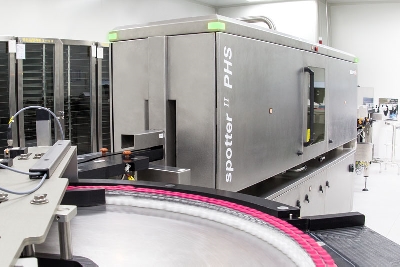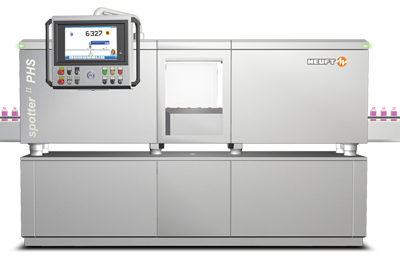"No changes detectable"
Samuel Razzak, Sales Manager Pharma at HEUFT, deals with the effect of an X-ray inspection on the quality of active pharmaceutical ingredients (APIs) in a recent technical paper.
The scientific experiments and studies analysed by Mr Razzak confirm what his colleague Stephan Bachmeier has already predicted from his own practical experience regarding the X-ray inspection of APIs: the risk of negative consequences for their quality and effectiveness is extremely low – especially for pharmaceutical manufacturers who rely on pulsed X-ray technology which is only available from HEUFT. You can find out more about this in an article by the HEUFT expert which has already been published in a pharmaceutical trade journal and which we will publish in full again here:

Effect of an X-ray inspection on the quality of the APIs
Quality assurance in the manufacturing and packaging process of pharmaceuticals is an essential step along every production line. Testing can be carried out manually, semi-automatically or fully automatically in order to maintain the high standards.
The use of X-ray inspection technology has extended to the pharmaceutical industry which uses it to detect missing materials and defective goods in opaque containers. It is used to check the presence of tablets in aluminium foil blister packs, foreign objects in products with active pharmaceutical ingredients (APIs) and to examine the fill level.
Regulatory guidelines and the effects of an X-ray inspection
The European Medicines Agency (EMA) has issued rules regulating the exposure of medicinal products to X-rays (3AQ4a). Nevertheless the use of X-ray inspection technology is still questioned by many pharmaceutical manufacturers. X-rays have short wavelengths implying a high energy supply which could possibly break the covalent bonds of the molecules. They also ionise water molecules and generate radicals which can break covalent bonds – a process which is useful in the radiation therapy of some cancer types.
In this essay we would like to focus on the available inspection solutions with integrated X-ray technology and their impact on the quality of APIs. We would also like to highlight the responsibility of pharmaceutical manufacturers who integrate
X-ray inspection devices into their production lines.

Available X-ray technologies
Many pharmaceutical machine suppliers have responded to the market demands and developed various technologies in different combinations for integrating X-ray generators: high-voltage X-ray emitting generators, low-voltage X-ray emitting generators and pulsed X-ray emitting generators.
The high and low voltage tubes emit constant uninterrupted X-rays. A shutter can be installed in front of the X-ray source consisting of metallic lamella which is not translucent to X-rays in order to minimise the exposure time. This is synchronised with the speed of the conveyor or the rotator so that each product to be inspected is exposed to X-rays for a defined period of time.
The pulsed X-ray is in contrast an interrupted generation of radiation. Each product to be inspected is exposed to an X-ray pulse for a certain period of time, the frequency of which adapts to the conveying or rotating speed. For the time being there is only one known supplier of the pulsed X-ray technology: the German manufacturer HEUFT SYSTEMTECHNIK GMBH underlines the low energy emission of the X-ray tubes in their inspection units.
The inspection task can thus be mastered depending on the intensity and the exposure time of the X-rays. However any of the technologies mentioned above are useless if the resulting images are not processed in an adequate manner. Good image processing software which provides a sensitive and reliable pattern recognition can compensate the gap resulting after exposure to X-rays generated by low-energy X-ray generators.
The effect of X-rays on APIs
The influence of X-rays on two model substances was compared with the influence of UV radiation present in daylight in a joint project between a machine supplier and a well-known pharmaceutical manufacturer. The API nifedipine is known to be sensitive to daylight. The photodegradation of nifedipine shows a value of approximately ten percent every 30 minutes under normal daylight conditions. Tramadol HCl, on the other hand, is a stable product. Both model substances were subjected to X-ray irradiation for two hours and compared to a photodegradation rate after 30 minutes exposure to artificial daylight. Degradation was not observed either for nifedipine or tramadol HCl when exposed to X-rays – and that in a worst-case scenario of two hours of uninterrupted X-ray exposure. Tramadol HCl remained stable even after 30 minutes of artificial daylight. However nifedipine showed an increasing photodegradation over time of up to 10.06% of the total API mass.
Uehara et al. conducted similar experiments on nifedipine tablets, acetaminophen, loxoprofen and mefenamic acid. Active ingredient content, dissolution, disintegration, hardness and colour were set as test parameters. Each medicine packaged in a blister pack was fractionated into five groups. The fractions were exposed to various X-ray doses successively: 0 Gy, 0.34 mGy, 0.1 Gy, 0.5 Gy and 300 Gy.
The X-rays did not cause any significant negative change to the APIs. The results also demonstrated that the X-ray exposure did not affect the pharmaceutical quality regarding dissolution, degradation and hardness in this series of tests. Only nifedipine showed changes in colour and signs of disintegration after exposure to X-rays under daylight conditions but this is solely attributable to the effect of daylight on the UV unstable preparation. On the other hand exposure to X-rays in the dark chamber did not cause any changes whatsoever. None are known so far for most other pharmaceutical products either. Aluminium foil sealing is an effective method to protect tablets from moisture and an X-ray inspection is a promising method to check the presence of tablets in blister packs.

Low energy consumption and low radiation
The X-ray inspection is also used for the quality assurance of liquids, gels, pastes and lyophilised products. No negative impact on APIs has been observed in the course of this up to now. This is due on the one hand to the low energy of the X-rays and on the other hand to the very short exposure times. An exposure period of 250 ms is the common standard. However for each tested product with low-energy pulsed X-ray technology this is a maximum of 1 ms.
X-ray inspection systems from HEUFT only subject each product to an additional energy input of a maximum of 10 µGy and the measured irradiation inside the glass container containing APIs amounts to approximately 2.5 µGy due to the reflection effect of the outer packaging. In comparison a flight between Paris and San Francisco causes an exposure of about 110 µGy due to cosmic X-rays. Consequently it is rather hard to imagine that the use of such an inspection solution with significantly lower values by comparison could result in a loss in quality.
Manufacturer responsibility and physical limit values for X-rays
At the same time, it is the responsibility of the pharmaceutical manufacturers to ensure the quality of medicines when using X-ray technology. The above-mentioned examples cover a wide range of pharmaceutical formulations but of course do not provide a quality certificate for every inspected product. Medicinal products containing living organisms, proteins or other sensitive biopharmaceuticals should rather be checked for their integrity and quality after an X-ray inspection.
Most suppliers of inspection machines support such analyses but it remains the task and responsibility of pharmaceutical manufacturers to initiate these tests. It is also utopic to consider the X-ray inspection as the ultimate solution in quality management. It too has its limits: organic foreign objects such as hair fibres or low density materials such as plastic film and fragments are hardly visible in the X-ray image. Glass and metal splinters which have a significantly higher density than the product can in contrast, among other things, be reliably detected.
Most pharmaceutical manufacturers express the wish to detect foreign objects with a diameter of 50 µm. However the realistic size of the contaminants to be detected is above 200 µm and the detection rate for the time being is below 70%. This detection performance depends on many limiting factors – many on the material of the foreign object (organic, inorganic, metal etc.), the physical features of the container (material, shape, thickness and transparency) as well as the position of the particle in relation to the container walls.
Conclusion: a promising process
In the light of the above information it can be concluded that the pulsed X-ray inspection is a promising method to ensure the presence and integrity of packaged medicinal products, to check the correct fill level height of medicinal products and to detect high density contaminating foreign objects in translucent and non-translucent containers. No quality reducing effects are known so far due to the short exposure time to X-rays and the pharmaceutical machine industry tends to use low-energy X-rays in order to minimise any potential negative effects. It is unscientific to exclude all possible effects on the molecular structure of each medicine after an X-ray inspection which is why in case of uncertainty it is the responsibility of the pharmaceutical manufacturer to analyse the effects of X-ray exposure on certain sensitive APIs.
Samuel Razzak, HEUFT SYSTEMTECHNIK GMBH





